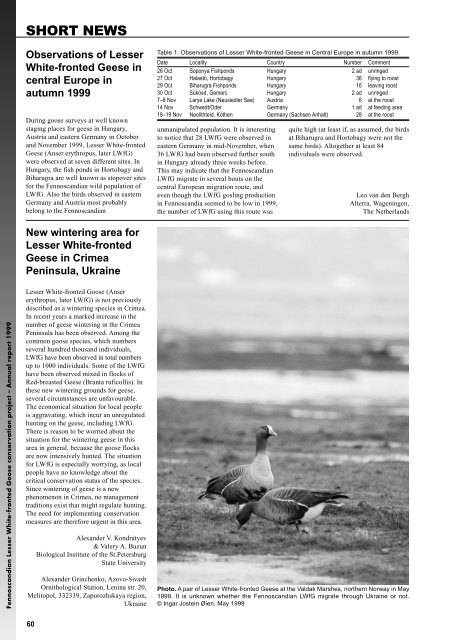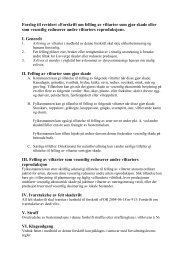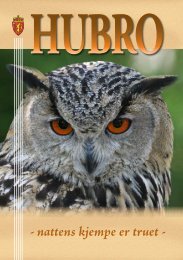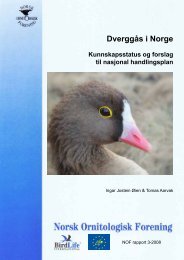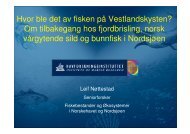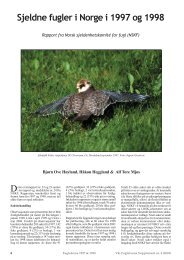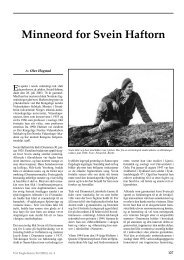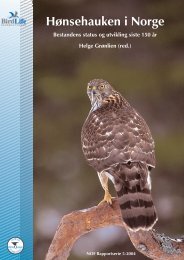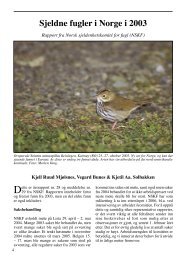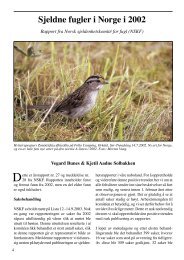Fennoscandian Lesser White-fronted Goose conservation project ...
Fennoscandian Lesser White-fronted Goose conservation project ...
Fennoscandian Lesser White-fronted Goose conservation project ...
Create successful ePaper yourself
Turn your PDF publications into a flip-book with our unique Google optimized e-Paper software.
<strong>Fennoscandian</strong> <strong>Lesser</strong> <strong>White</strong>-<strong>fronted</strong> <strong>Goose</strong> <strong>conservation</strong> <strong>project</strong> – Annual report 1999<br />
SHORT NEWS<br />
Observations of <strong>Lesser</strong><br />
<strong>White</strong>-<strong>fronted</strong> Geese in<br />
central Europe in<br />
autumn 1999<br />
During goose surveys at well known<br />
staging places for geese in Hungary,<br />
Austria and eastern Germany in October<br />
and November 1999, <strong>Lesser</strong> <strong>White</strong>-<strong>fronted</strong><br />
Geese (Anser erythropus, later LWfG)<br />
were observed at seven different sites. In<br />
Hungary, the fish ponds in Hortobagy and<br />
Biharugra are well known as stopover sites<br />
for the <strong>Fennoscandian</strong> wild population of<br />
LWfG. Also the birds observed in eastern<br />
Germany and Austria most probably<br />
belong to the <strong>Fennoscandian</strong><br />
New wintering area for<br />
<strong>Lesser</strong> <strong>White</strong>-<strong>fronted</strong><br />
Geese in Crimea<br />
Peninsula, Ukraine<br />
<strong>Lesser</strong> <strong>White</strong>-<strong>fronted</strong> <strong>Goose</strong> (Anser<br />
erythropus, later LWfG) is not previously<br />
described as a wintering species in Crimea.<br />
In recent years a marked increase in the<br />
number of geese wintering in the Crimea<br />
Peninsula has been observed. Among the<br />
common goose species, which numbers<br />
several hundred thousand individuals,<br />
LWfG have been observed in total numbers<br />
up to 1000 individuals. Some of the LWfG<br />
have been observed mixed in flocks of<br />
Red-breasted Geese (Branta ruficollis). In<br />
these new wintering grounds for geese,<br />
several circumstances are unfavourable.<br />
The economical situation for local people<br />
is aggravating, which incur an unregulated<br />
hunting on the geese, including LWfG.<br />
There is reason to be worried about the<br />
situation for the wintering geese in this<br />
area in general, because the goose flocks<br />
are now intensively hunted. The situation<br />
for LWfG is especially worrying, as local<br />
people have no knowledge about the<br />
critical <strong>conservation</strong> status of the species.<br />
Since wintering of geese is a new<br />
phenomenon in Crimea, no management<br />
traditions exist that might regulate hunting.<br />
The need for implementing <strong>conservation</strong><br />
measures are therefore urgent in this area.<br />
60<br />
Alexander V. Kondratyev<br />
& Valery A. Buzun<br />
Biological Institute of the St.Petersburg<br />
State University<br />
Alexander Grinchenko, Azovo-Sivash<br />
Ornithological Station, Lenina str. 20,<br />
Melitopol, 332339, Zaporozhskaya region,<br />
Ukraine<br />
Table 1. Observations of <strong>Lesser</strong> <strong>White</strong>-<strong>fronted</strong> Geese in Central Europe in autumn 1999.<br />
Date Locality Country Number Comment<br />
26 Oct Soponya Fishponds Hungary 2 ad unringed<br />
27 Oct Halastö, Hortobagy Hungary 36 flying to roost<br />
29 Oct Biharugra Fishponds Hungary 16 leaving roost<br />
30 Oct Sükösd, Gemerc Hungary 2 ad unringed<br />
7–8 Nov Larye Lake (Neusiedler See) Austria 6 at the roost<br />
14 Nov Schwedt/Oder Germany 1 ad at feeding area<br />
18–19 Nov Neolithteid, Köthen Germany (Sachsen Anhalt) 28 at the roost<br />
unmanipulated population. It is interesting<br />
to notice that 28 LWfG were observed in<br />
eastern Germany in mid-November, when<br />
36 LWfG had been observed further south<br />
in Hungary already three weeks before.<br />
This may indicate that the <strong>Fennoscandian</strong><br />
LWfG migrate in several bouts on the<br />
central European migration route, and<br />
even though the LWfG gosling production<br />
in Fennoscandia seemed to be low in 1999,<br />
the number of LWfG using this route was<br />
quite high (at least if, as assumed, the birds<br />
at Biharugra and Hortobagy were not the<br />
same birds). Altogether at least 84<br />
individuals were observed.<br />
Leo van den Bergh<br />
Alterra, Wageningen,<br />
The Netherlands<br />
Photo. A pair of <strong>Lesser</strong> <strong>White</strong>-<strong>fronted</strong> Geese at the Valdak Marshes, northern Norway in May<br />
1999. It is unknown whether the <strong>Fennoscandian</strong> LWfG migrate through Ukraine or not.<br />
© Ingar Jostein Øien, May 1999


